Effective Techniques for Spot Treating Lawn Weeds
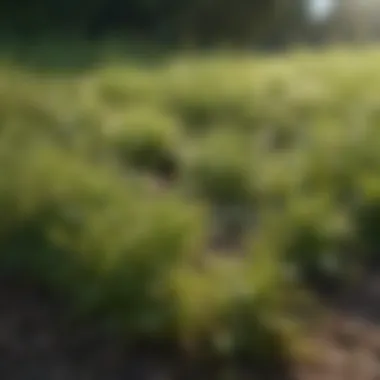
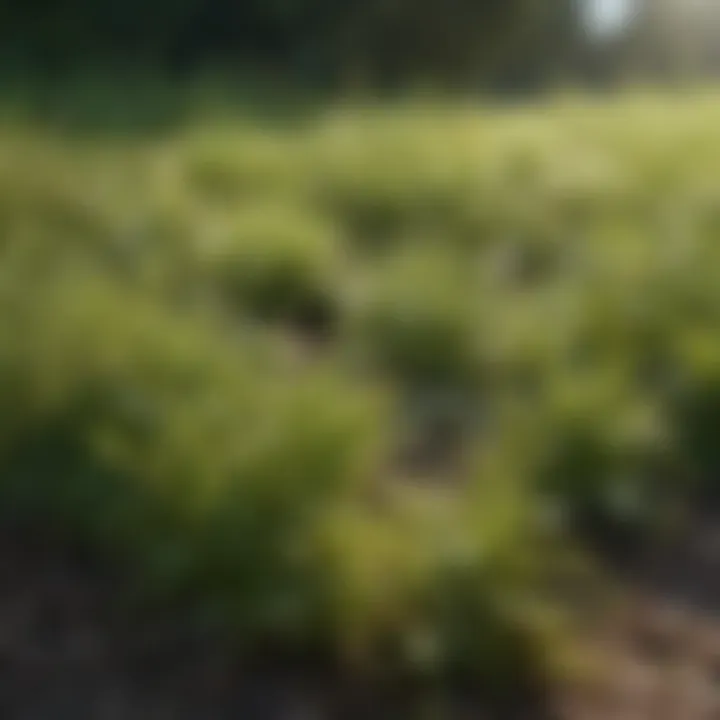
Intro
Weeds are a persistent problem for many gardeners and homeowners. They can invade lawns, competing for nutrients and space, and ultimately leading to unhealthy grass. Spot treating weeds is an effective strategy to manage this issue without resorting to blanket applications that can harm beneficial plants and soil organisms. Understanding how to identify specific weed types and utilizing targeted treatments is key to maintaining a healthy lawn.
This article explores the methods of spot treating weeds, emphasizing the importance of a focused approach. For both novice and seasoned gardeners, mastering these techniques allows for better lawn care while promoting eco-friendly practices.
Key Concepts and Terminology
Basic Definitions
Weed: A weed is any plant that is considered undesirable, troublesome, or invasive in a specific context, particularly in lawns and gardens.
Spot Treatment: This term refers to the application of herbicides or other weed control methods to specific areas, targeting only the weeds rather than treating the entire lawn.
Historical Context
Historically, weed management has evolved from labor-intensive hand weeding to the use of chemical herbicides. Over the years, advancements in agricultural practices have led to targeted control methods that minimize environmental impact. Understanding the history of these practices can provide insight into modern techniques.
Recent Innovations and Trends
Technological Advancements
Recent developments in technology have improved precision in spot treatment. For instance, GPS-enabled sprayers allow for more accurate application, reducing chemical usage and enhancing effectiveness. Furthermore, real-time monitoring tools help identify weed infestations early, facilitating quicker responses.
Sustainable Practices
Sustainability is now a key concern for many gardeners. Organic herbicides are gaining popularity as gardeners seek eco-friendly alternatives to traditional chemicals. Using natural solutions like vinegar or salt can effectively control certain weeds without harming the environment.
Practical Applications and Techniques
Step-by-step Guides
- Identify the Weeds: Begin by observing the lawn to determine which weeds are prevalent. Identifying the type of weed is crucial for choosing the right treatment.
- Select Appropriate Treatments: Once the weed type is known, research suitable treatments. For example, dandelions may require a different approach compared to crabgrass.
- Apply Treatment: Use a targeted application method. This could be a spray applicator for liquid treatments or a spot treatment with granular products.
- Monitor for Effectiveness: After treatment, closely observe the affected area. Ensure that the weeds are responding to the treatment and make adjustments if necessary.
- Follow-Up Maintenance: To prevent the reemergence of weeds, maintain a regular lawn care schedule, including aeration, fertilization, and overseeding where needed.
Case Studies
Analyzing case studies provides valuable insights into effective weed management strategies. For instance, a suburban lawn that employed targeted herbicide application resulted in a 75% reduction in weed population over a single growing season, particularly for annual weeds. Conversely, lawns that relied solely on generic treatments saw only a 25% reduction, emphasizing the importance of specificity in weed control.
"Targeted weed control not only promotes healthier lawns but also minimizes the impact on the environment and surrounding ecosystems."
By understanding and implementing these techniques, gardeners can achieve effective weed management that is sustainable and healthy for their lawns.
Understanding the Importance of Spot Treatment
In lawn care, effective management of weeds is essential for achieving a healthy and vibrant yard. Spot treatment is a focused approach, allowing gardeners to target specific weed infestations instead of applying treatments to the entire lawn. This method minimizes the use of chemicals, reduces the impact on beneficial plants, and addresses weed growth more efficiently. Understanding the significance of spot treatment provides the foundation for better weed control practices within the lawn management toolkit.
Defining Spot Treatment
Spot treatment can be defined as the method of applying weed control substances directly to specific areas of the lawn that are affected by weeds. This differs markedly from blanket applications, where chemicals are sprayed or spread across the entire lawn, regardless of whether every area is afflicted by invasive plants. Spot treatments are tailored interventions that offer precision in targeting problem areas, allowing for more judicious use of resources and reducing the potential for negative environmental impact.
Advantages Over Broad Treatments
Using spot treatment methods offers notable advantages:
- Resource Efficiency: By only treating areas that require intervention, gardeners conserve herbicides and reduce costs over time.
- Reduced Chemical Exposure: Minimizing chemical applications leads to lower risks for other plants, soil life, and pollinators, which is crucial for maintaining an eco-friendly yard.
- Effectiveness: This focused approach allows for quick intervention in the lifecycle of weeds, importantly addressing issues before they proliferate.
- Customization: Spot treatment can be adjusted based on the specific type of weed, soil conditions, and local climate variations, making it a personalized strategy for weed management.
"The goal of effective lawn care is not just to eliminate weeds, but to maintain the ecological balance of the garden."
Identifying Common Lawn Weeds
Identifying common lawn weeds is crucial for effective lawn care. The presence of weeds can disrupt the overall health of your grass and soil. Understanding the types of weeds allows for targeted approaches that minimize damage and enhance growth for desired plants. Recognizing specific weed types provides gardeners with the knowledge needed to select appropriate treatments. Moreover, early identification can prevent a small problem from becoming a larger one, saving time and resources in the long run.
Annual versus Perennial Weeds
When identifying weeds, it is essential to differentiate between annual and perennial types. Annual weeds complete their lifecycle in one growing season. These include species like crabgrass, which germinates, grows, seeds, and dies within a year. On the other hand, perennial weeds live for multiple seasons. They often have deeper root systems and can reappear year after year, such as dandelions. Recognizing these differences helps determine the best strategy for control. Annual weeds may require pre-emergent treatments, while perennial weeds may need more persistent methods due to their resilience.
Identifying Specific Weeds
Crabgrass
Crabgrass is an annual weed that commonly appears in lawns. It has wide, flat leaves that grow close to the ground. One of its key characteristics is its rapid growth, allowing it to outcompete desirable grasses for nutrients and sunlight. Its presence in lawns signals the need for pre-emergent treatments that restrain its ability to germinate. Understanding crabgrass is vital as it can form dense patches, making lawn maintenance challenging.
Dandelion
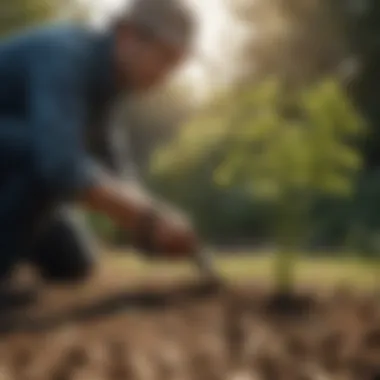
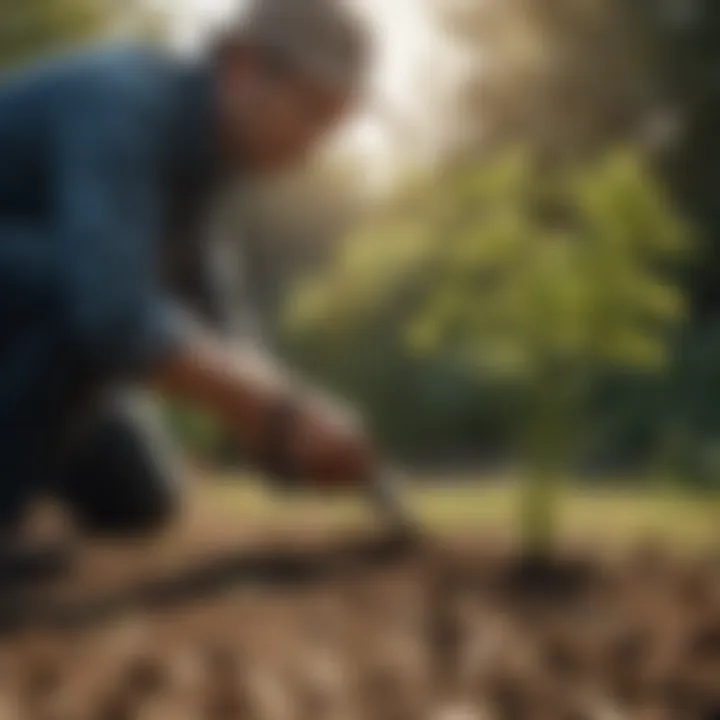
Dandelions are recognized for their bright yellow flowers and fuzzy seed heads. This perennial weed has a long taproot, making it difficult to control once established. One notable feature of dandelions is their ability to thrive in various soil conditions, which adds to their adaptability. In the context of this article, it is important to recognize that while dandelions can be unsightly, they also serve ecological purposes, such as attracting pollinators. Their eradication may require careful consideration of control methods to balance lawn aesthetics and ecological impact.
Thistle
Thistles are another type of perennial weed that often invades lawns. They can grow tall and aggressive, with prickly stems and leaves. One major characteristic of thistles is their ability to produce numerous seeds, which can facilitate rapid spread. Recognizing thistle varieties is essential for effective management. Thistles can be particularly challenging due to their strong root systems and ability to reproduce vegetatively. For these reasons, targeted spot treatments should focus on both cut and chemical approaches. Understanding whether it is Canada thistle or another species will shape the approach to removal.
"Identifying common lawn weeds not only aids in targeted treatments but also preserves the overall ecosystem of the garden."
Effective identification of these common weeds allows gardeners to choose the right control techniques, leading to healthier lawns and reduced weed problems.
Evaluating Lawn Health Before Treatment
Before one embarks on the journey of spot treating weeds, it is crucial to evaluate the overall health of the lawn. This step ensures that any treatment applied does not inadvertently harm the grass or soil. A healthy lawn is better equipped to resist weed encroachment and recover from any management practices. Understanding the specific requirements and conditions of your lawn can significantly influence the outcome of spot treatments.
Analyzing Soil Quality
Soil is the foundation of any lawn. To assess soil quality, consider the following aspects:
- Soil pH: The pH level can affect nutrient availability. Most lawns thrive in slightly acidic to neutral pH (around 6.0 to 7.0). Testing kits are readily accessible and can provide useful data.
- Nutrient Levels: Soil tests can reveal levels of nitrogen, phosphorus, potassium, and other nutrients essential for grass health. Determining deficiencies allows for targeted amendments that improve soil fertility before or during a weed treatment process.
- Drainage: Good drainage is vital. Poorly drained soil can lead to problems like fungal diseases or loss of grass vigor, which can consequently create conducive conditions for weeds. Observe areas of pooling water, as this could indicate drainage issues.
By analyzing soil quality, one can establish a baseline for improvement, ensuring that any measures taken are effective and sustainable.
Assessing Grass Condition
Evaluating the condition of the grass is equally important. A robust lawn can compete better against weeds, while weak areas may need immediate attention. Here are some factors to assess:
- Grass Variety and Health: Different grass species have distinct qualities. Understanding your specific grass type helps in deciding how to manage it effectively. Ensure that the grass is free from diseases or pests that could weaken its stance against weeds.
- Density and Growth: A thick lawn is less likely to succumb to weed infestations. If patches are sparse or thinning, it may be necessary to reseed or aerate before any weed treatment. Look for signs of stress from foot traffic or poor sunlight exposure.
- Moisture Levels: Grass health is linked to optimal water balance. Check for signs of drought stress or overwatering. An adequately hydrated lawn is more resilient and prepares well for treatment applications.
Evaluating the condition of the grass not only provides insight into the current issues but also informs future management plans, resulting in a healthier lawn overall. Understanding these details can guide the gardener in making informed decisions that promote healing rather than harm during the spot treatment process.
Choosing the Right Treatment Methods
Choosing the right treatment methods for weed control is crucial for maintaining a healthy lawn. When approaching the complexities of weed management, understanding various techniques and their effects can significantly impact both grass health and the environment. Effective spot treatment requires a multi-faceted approach that balances efficacy with sustainability. This section delves into mechanical methods, chemical treatments, and natural alternatives, elucidating how each method fits into a comprehensive weed management strategy.
Mechanical Methods
Hand Pulling
Hand pulling is a straightforward method for controlling weeds and contributes significantly to effective spot treatment. The key characteristic of hand pulling is its simplicity; it requires no special equipment or chemicals, making it accessible for everyone. This method is especially beneficial for removing small populations of weeds without disturbing the surrounding soil too much.
The unique feature of hand pulling lies in the gardener’s ability to target individual weeds accurately. This method does not introduce any harmful chemicals to the lawn or surrounding environment, thereby preserving the integrity of the ecosystem. However, it has its disadvantages. The process can be labor-intensive and may not be practical for larger infestations. Moreover, if the entire root is not removed, the weed may regrow.
Weed Wrench
A weed wrench is a specialized tool designed to tackle deep-rooted weeds effectively. This method helps in the removal of larger weeds and those with extensive root systems that may be challenging to uproot by hand. The key characteristic of a weed wrench is its mechanical advantage, which allows users to exert leverage, making it easier to pull stubborn weeds.
The unique feature of the weed wrench is its ability to remove entire root systems without disturbing surrounding plants. This is particularly effective for invasive weeds. Nevertheless, using a weed wrench may require some familiarity with the tool, and its effectiveness can vary based on the user’s strength and technique.
Chemical Treatments
Selectivity of Herbicides
The selectivity of herbicides is an essential aspect of effective weed management. Selective herbicides are designed to target specific weed species while minimizing damage to desirable plants. The key characteristic of this approach is precision; it enables gardeners to effectively control weeds without compromising the overall health of the lawn.
One of the advantages of using selective herbicides includes their ability to minimize the broader impact on the ecosystem. However, improper application or the use of non-selective herbicides can harm beneficial plants. Proper methodology and equipment are key to maximizing their benefits.
Pre-emergent versus Post-emergent
Understanding the difference between pre-emergent and post-emergent herbicides is crucial for effective weed control. Pre-emergent herbicides work by preventing weed seeds from germinating, thus controlling weeds before they even appear. In contrast, post-emergent herbicides target existing weeds. Each type serves a different purpose in a gardener's toolkit.
Using pre-emergent herbicides can be beneficial in preventing issues before they arise, but timing is critical for success. Post-emergent herbicides provide a solution for current weed problems but may require multiple applications for complete control. Both types have advantages and disadvantages based on timing, type of weeds, and environmental considerations within the lawn management strategy.
Natural Alternatives
Vinegar Solutions
Vinegar solutions provide an organic option for weed control. Commonly, household vinegar can be used as a non-selective herbicide due to its acetic acid content, which can harm many types of plants. The key characteristic of vinegar solutions is their eco-friendliness; they do not introduce harmful chemicals into the environment.
Vinegar is a popular choice among gardeners seeking environmentally sustainable solutions, although its effectiveness may vary based on the concentration of acetic acid and the type of weeds being treated. There are some disadvantages as well, like the potential for damage to desirable plants nearby if not applied carefully.
Boiling Water
Using boiling water as a weed treatment is another natural approach that adds precision to weed management. This method works by killing weeds through extreme heat, effectively cooking them. The key characteristic of boiling water is its immediacy; it delivers a quick solution to target weeds without any synthetic chemicals.
This method is particularly advantageous for small areas or isolated weeds since it is easy to apply. However, it also has disadvantages; the temperature must be carefully controlled to avoid damaging healthy grass or other desired plants. Additionally, boiling water is only effective on annual weeds, as perennial weeds may withstand the heat by preserving their roots.
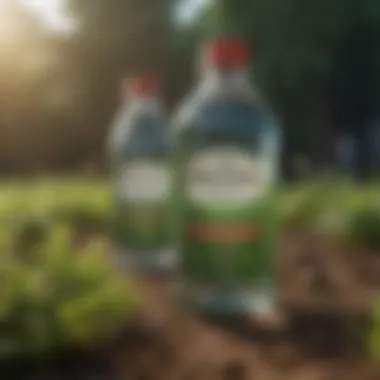

Overall, selecting the appropriate treatment method depends not only on the specific weed type but also on personal gardening philosophy, environmental concerns, and the desired outcome. By weighing these factors, lawn care enthusiasts can make informed decisions.
Preparation for Spot Treatment
Preparing for spot treatment is a vital step in effectively managing weeds in your lawn. Proper preparation not only enhances the efficiency of the treatment but also minimizes the risk of harming desired grass and plants. Key elements to focus on include timing the application and understanding weather conditions.
Timing the Application
Timing is crucial for the success of spot treatments. Applying herbicides or natural treatments at the correct time can greatly affect their effectiveness. Early morning or late afternoon is often the best time for application. At these times, temperatures are cooler, which helps in reducing evaporation and allows the treatment to penetrate the weeds more efficiently.
Additionally, targeting weeds when they are actively growing increases the likelihood of success. For most weeds, this means treating them in the spring or early summer. Observing the growth stages of specific weed types can offer guidance on the best timing for application.
"Applying treatments when weeds are actively growing ensures better absorption and effectiveness."
Furthermore, consider the life cycle of the weeds. Annual weeds, for instance, are typically more vulnerable early in their growth phase, whereas perennial weeds can require multiple treatments over time.
Weather Considerations
Weather conditions significantly influence the outcome of your spot treatment efforts. Ideally, treatments should be applied on a dry day with no forecast for rain shortly after application. Rain can dilute or wash away treatments, leading to ineffective results. It is also wise to avoid applying herbicides during windy conditions, as this can cause drift, affecting non-target plants and areas.
Humidity also plays a role; high humidity can slow down drying times, potentially increasing the risk of unintended damage to desirable plants. Conversely, excessively dry conditions may lead to evaporation before the herbicide has time to work effectively.
In summary, ensuring both the timing and weather conditions are optimal will make a significant difference in the success of spot treatments. These preparatory steps not only protect your lawn's health but also support effective weed management over the long term.
Applying Spot Treatments Effectively
Effective spot treatment is an essential practice for maintaining a healthy lawn. It focuses on targeting specific areas where weeds are prevalent without affecting the surrounding grass. This method provides several benefits. Most importantly, it minimizes the use of chemicals, which is preferable for both the environment and the overall health of your lawn. By concentrating on problem areas, you can apply treatments more precisely, ensuring the weeds receive the attention they require without harming other plants.
When spot treating, it is essential to consider the proper equipment and application techniques. These choices influence the overall effectiveness of your treatments while reducing the risk of collateral damage to desirable plants in your lawn.
Utilizing Proper Equipment
Sprayers for Precision
Using sprayers for precision is a vital part of effective spot treatment. They allow the user to apply herbicides or other treatments selectively. A key characteristic of precision sprayers is their ability to control the droplet size and direction of the application. This feature enables gardeners to target weeds directly, minimizing overspray and thus reducing unintended harm to surrounding vegetation.
Precision sprayers come in various forms, from handheld models to larger backpack sprayers. This versatility makes them beneficial for both small and large lawns. The unique feature of having adjustable nozzles can make a significant difference. Users can switch between fine mist for delicate weed leaves and a more focused stream for larger weeds. However, care must be taken in their operation, as improper use can still lead to some drift.
Application Techniques
Effective application techniques are critical to ensure that the treatment is absorbed by the target weed while avoiding unnecessary exposure to other plants. A primary aspect of these techniques includes consistent observation of the weed's condition, weather patterns, and the time of day for application. This specificity allows for optimal absorption and effectiveness.
One of the key characteristics of good application techniques is ensuring fog or mist is minimized. This ensures that the product lands where intended, rather than being carried off by the wind. Applying on windless days is a common recommendation in the practice of effective spot treatment. Applying treatments early in the morning or later in the afternoon also increases the effectiveness as temperatures can be cooler and plants are more receptive to absorption.
Practices that involve testing small areas before treating larger patches can also prove advantageous. Observing how a few weeds respond to the treatment can inform decisions about the necessary amount or concentration needed for broader application. However, always remember that while techniques can improve spot treatment, adherence to safety measures and having a clear plan is paramount.
Avoiding Non-target Damage
Avoiding non-target damage is a fundamental aspect of effective weed control. When applying treatments, it is vital to ensure that non-target plants and the ecosystem are protected. This can be achieved by carefully selecting where and when to apply treatments, as well as what products to use.
Implementing strategies such as creating physical barriers around the treatment area or using selective herbicides that target specific weed types can greatly reduce the risk of damaging desirable plants. Knowledge of your landscape, including sensitive plants and soil types, can help tailor your approach effectively.
Proper planning and awareness lead to successful spot treatments that keep your lawn healthy while managing weeds efficiently.
By utilizing proper equipment, mastering application techniques, and remaining vigilant against non-target damage, gardeners can achieve their desired results in maintaining a healthy lawn. These approaches not only promote efficient weed management but also ensure that the overall health of the lawn is taken into consideration.
Post-Treatment Maintenance
Post-treatment maintenance is crucial for the overall health of your lawn following the application of spot treatments for weeds. Effective maintenance not only ensures that the treatments work as intended but also promotes the resilience of the surrounding grass. The approach you take in this phase can directly influence the longevity of your lawn’s health and its ability to fend off future weed invasions.
Monitoring Weed Response
Monitoring weed response after treatment is essential. This involves observing the targeted areas for signs of weed die-off and any possible regrowth. Key indicators include yellowing of leaves or death in treated weeds. Monitoring should take place at regular intervals—ideally, every few days for the first couple of weeks.
After treatment, some specific aspects to consider include:
- Timing of Follow-Up Observations: Initial observations can begin within 48 hours, as some herbicides show effects quickly.
- Weed Type Influence: Different weeds have various resilience levels; perennial weeds might require multiple treatments.
- Environmental Factors: Rainfall and sunlight can affect treatment efficacy. An early rain can wash away treatments.
Taking notes on what works—and what does not—will help refine future approaches. Always document which species were treated and the method used, as this will provide valuable insights for subsequent seasons.
Maintaining Lawn Health
Maintaining lawn health after weeds have been treated should be a priority. The goal is to recover any potential stress to your grass from herbicide application while deterring further weed growth. You can enhance lawn health through several practices:
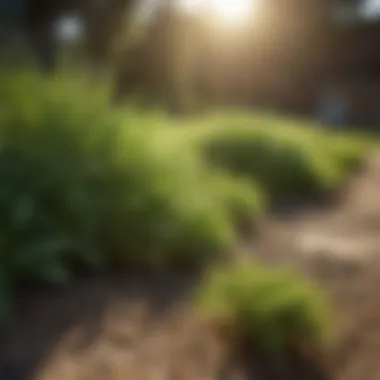

- Watering: Deep watering helps your grass recover and compete more effectively against weeds. Aim for about one inch per week, spread over two waterings.
- Aeration: Regular aeration helps to relieve soil compaction, allowing water, nutrients, and air to reach the roots more effectively.
- Fertilization: Following spot treatments, applying a balanced fertilizer can support grass health. This will also help the grass outcompete any remaining weeds.
- Mowing: Maintain an appropriate mowing height. Keep the grass at 2.5 to 4 inches tall, depending on the type. Taller grass shades the soil, making it more difficult for weeds to survive.
Effective post-treatment management can lead to a significantly healthier lawn, reducing the risk of weed resurgence while enhancing the overall beauty of your landscape.
In summary, successful post-treatment maintenance requires diligent monitoring and nurturance of your lawn. This phase, often overlooked by many, is where the groundwork for a thriving lawn is laid. With consistent care, your efforts in spot treating will yield lasting results.
Long-term Strategies for Weed Control
Long-term strategies are essential for effective weed control. They not only manage current weed problems but also create a more resilient lawn in the future. By focusing on proactive measures, such as cultural practices and proper fertilization techniques, one can significantly mitigate the risk of weeds taking hold in the lawn. These strategies promote overall grass health, leading to a more vigorous turf that naturally competes against unwanted plants. This approach is particularly relevant to both novice and experienced gardeners who desire a well-maintained lawn without relying solely on chemical treatments.
Cultural Practices
Cultural practices play a vital role in maintaining healthy grass and preventing weed growth. They involve management techniques that strengthen the lawn's natural defenses.
Mowing Height Management
Mowing height management refers to the practice of cutting grass at an optimal height. It affects lawn health and growth. Keeping grass at the right height shades the soil, which reduces the light available for weed seeds. Studies indicate that mowing grass higher can lead to denser turf, which helps choke out weeds. Typically, a height of two to four inches is preferred, depending on the grass type.
The key characteristic of mowing height management is its simplicity. Homeowners can easily adopt this in their lawn care routines without considerable expense or effort. However, there is a downside to consider; if not done correctly, mowing too high can lead to other issues, such as pest invasion and fungal diseases.
Regular Aeration
Regular aeration ensures that the soil under the grass is well-oxygenated and able to absorb nutrients more effectively. This process involves perforating the soil with holes to allow air, water, and nutrients to penetrate down to the roots. Aeration significantly reduces soil compaction, creating a firmer environment for grass roots to grow. It can also disrupt the life cycles of some weeds by altering the conditions they thrive in.
The unique feature of regular aeration is its ability to improve lawn health in a relatively uncomplicated manner. This practice can be especially beneficial in areas with heavy clay soils. Despite its advantages, one must consider timing; aeration should typically occur during periods of active grass growth for maximum benefit.
Lawn Fertilization Techniques
Lawn fertilization techniques are an important part of long-term weed control. Proper fertilization provides the essential nutrients needed for healthy grass growth. A well-fed lawn develops a robust root system, making it more competitive against weeds. There are different fertilization methods, such as granular, liquid, and slow-release options.
Choosing the right technique can impact both the effectiveness of nutrient application and the health of the surrounding environment. Over-fertilizing can lead to excessive growth, which may invite more weed issues. Understanding the specific nutrient needs of the lawn is crucial to prevent creating conditions that favor weed germination.
"Proper lawn care involves a holistic approach, integrating cultural practices with fertilization to combat weed growth effectively."
Overall, incorporating these long-term strategies ensures a healthier lawn ecosystem and a significant reduction in weed issues over time.
Environmental Considerations
Understanding the environmental factors relevant to weed treatment is critical for both personal health and ecological integrity. The choice of treatment methods can have significant repercussions on local ecosystems, including soil health, water quality, and biodiversity. This section examines the impacts of chemical treatments and highlights eco-friendly practices that can mitigate adverse effects, fostering a sustainable approach to lawn care.
Impacts of Chemical Treatments on Ecosystems
The use of chemical herbicides is prevalent in weed management. However, their application can harm beneficial organisms and disrupt ecological balances. Common issues include:
- Contamination of Water Sources: Chemicals can leach into groundwater or wash into nearby streams, affecting aquatic life.
- Soil Health Degradation: Persistent chemicals can alter soil microbial communities, reducing their ability to decompose organic matter and recycle nutrients.
- Non-target Species Harm: While targeting specific weeds, these treatments often affect non-target plants, potentially leading to reduced biodiversity.
It is essential to understand these risks when treating lawns. Educating oneself on the specific herbicides used, their application rates, and the timing of treatments can lessen these negative impacts.
Eco-Friendly Practices
In light of the potential harms associated with chemical treatments, embracing eco-friendly practices is increasingly important. Here are some effective strategies:
- Utilizing Natural Herbicides: Products that contain vinegar or citric acid can control weeds without the risks associated with synthetic chemicals.
- Cultural Practices: Adjusting practices such as mowing height, overseeding, and proper lawn fertilization can naturally suppress weed growth by enhancing grass health.
- Mulching: Using organic mulch prevents weed germination while improving soil quality as it decomposes.
- Manual Removal: Regularly pulling weeds by hand, especially before they flower and seed, can effectively manage infestations with minimal ecological impact.
Adopting eco-friendly weed control practices not only supports healthier ecosystems but also safeguards the well-being of lawn enthusiasts and their communities.
In summary, being conscious of environmental considerations while spot treating weeds is indispensable. By selecting appropriate methods and integrating eco-friendly practices, one can promote a sustainable approach to lawn care that benefits both the homeowner and the environment.
Closure
The importance of the conclusion section in this article cannot be overstated. It serves as a vital synthesis of the significant points discussed throughout, summarizing the essential techniques and strategies for effective weed spot treatment. It highlights the advantages of targeted approaches, reinforcing the benefits of maintaining a healthy lawn without using broad treatments that can harm beneficial plants or the surrounding ecosystem.
In the realm of lawn care, effective weed management is as much about prevention as it is about treatment. Understanding key takeaway points helps to foster a proactive mindset.
Summarizing Key Points
In summarizing the key points, we focus on the fundamental aspects of spot treating weeds:
- Identification: Knowing the type of weeds present is crucial. We discussed differentiating between annual and perennial weeds, as well as how to identify specific varieties like crabgrass, dandelion, and thistle.
- Treatment Methods: We explored various methodologies, including mechanical, chemical, and natural treatment options. Each method has distinct advantages and potential drawbacks.
- Application Techniques: The implications of precise application were emphasized, underscoring the need for proper equipment and techniques to avoid damage to desired plants.
- Post-treatment Care: Monitoring the effectiveness post-treatment and ensuring ongoing lawn health were highlighted as critical steps in maintaining weed management.
"Continuous assessment and adjustment are keys to effective lawn care."
These points form the core of successful weed control and contribute to the longevity and vitality of your lawn.
Encouraging Seasonal Assessments
Encouraging seasonal assessments is essential for expert lawn care. Regular evaluations throughout the year allow for a deeper understanding of weed dynamics and the overall health of your lawn. This can be done through:
- Routine Inspections: Conduct checks every season to identify new weed growth or changes in existing weed populations. Early detection leads to quicker responses.
- Soil Testing: Analyze soil conditions at least once a year. This establishes a baseline for necessary amendments that foster grass growth while minimizing weed dominance.
- Adjusting Practices: As the seasons change, so do the conditions affecting your lawn. Adapt your treatment methods and care techniques, including timing for applications based on seasonal variations.
Regularly participating in these assessments not only enhances your strategy for weed control but also supports the long-term health of your lawn. By embracing observation and adaptability, you become more equipped to address weed threats efficiently.















